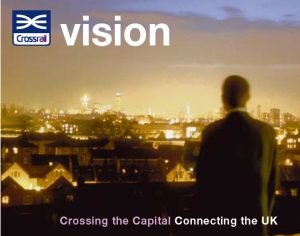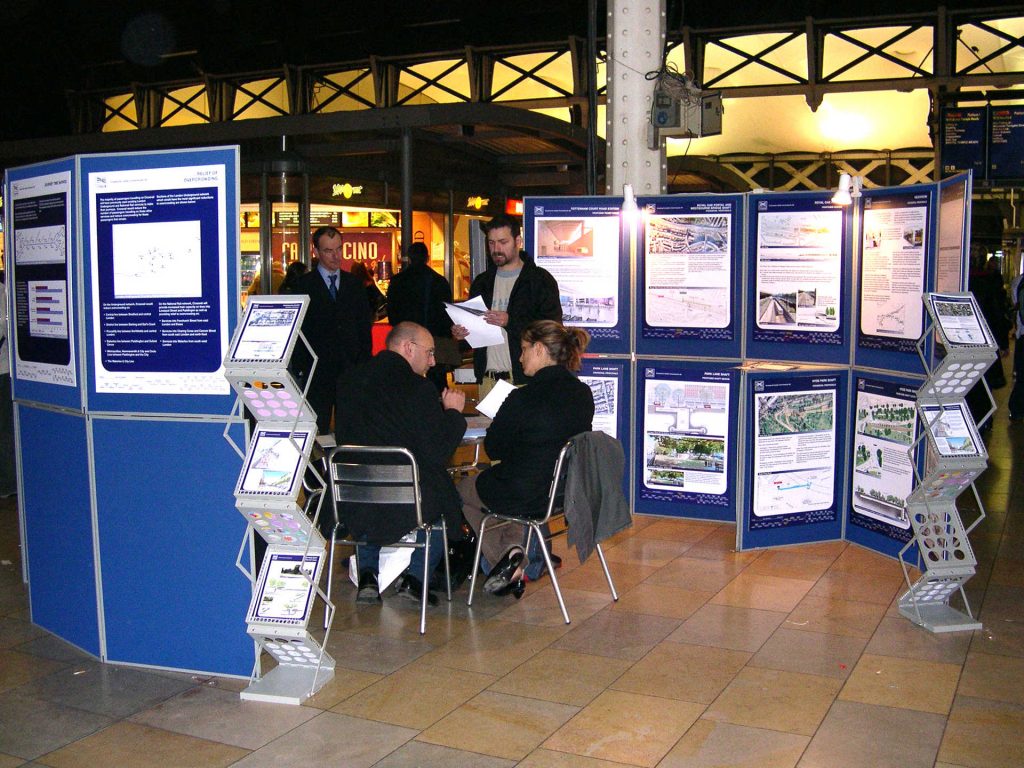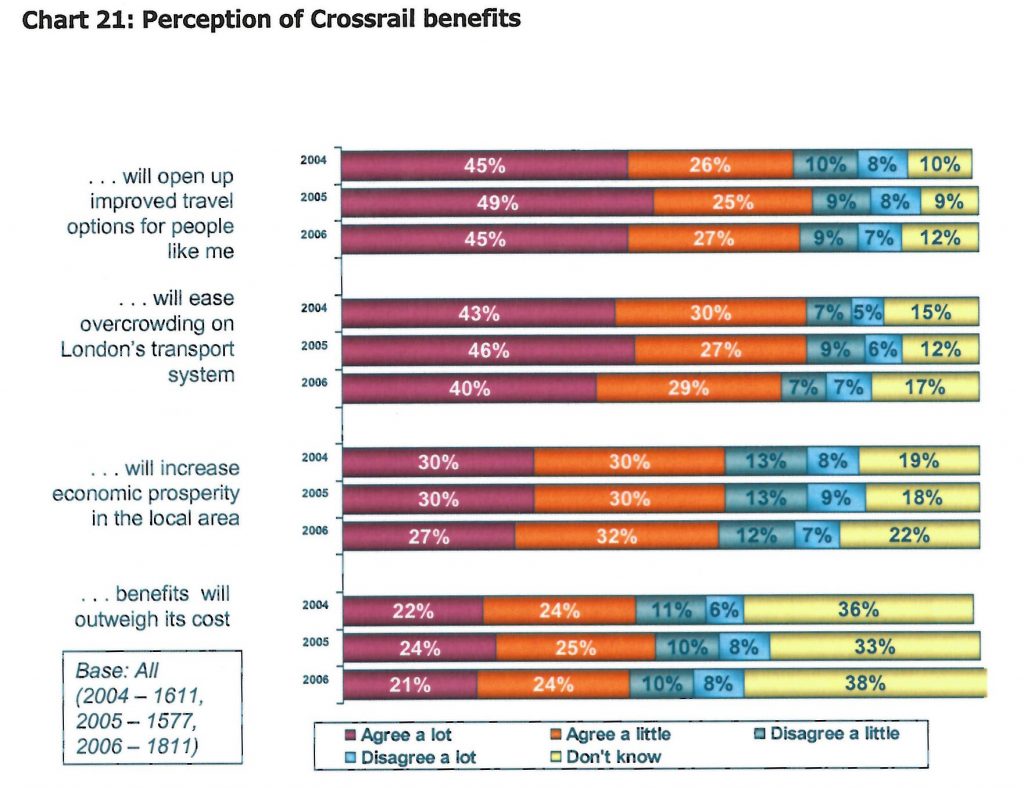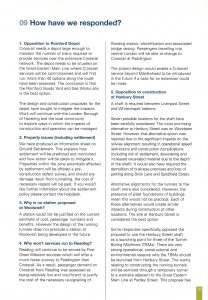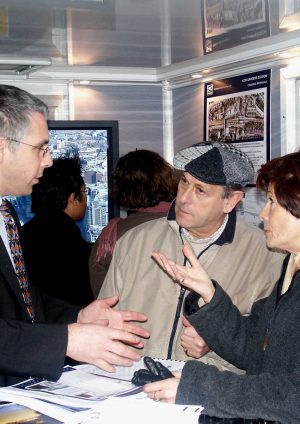
Organising the Crossrail consultation programme
Document
type: Case Study
Author:
Simon Bennett BEng(Hons) FCILT MCIPR AMICE
Publication
Date: 13/03/2018
-
Abstract
This case study explains how Crossrail ran the pre-authorisation consultation process, including setting the strategy, identifying consultees, communicating with property owners, what guidance existed and was used, establishing a helpdesk and a stakeholder database, production of material, resourcing and briefing engineering staff, analysis of responses, market research into reach, feedback to consultees and reporting internally. It assesses how successful this was in meeting its aims. The paper expands on the description of the consultation activity published in the Aggregated Consultation Report in 2005.
-
Read the full document
1. Introduction
Cross London Rail Links (CLRL) was established in 2001 with the aim of developing the Crossrail scheme to the point of being ready to make an application for powers. In the earliest stages consultants were engaged to augment the capability of the small CLRL team. Two members of the Crossrail team with experience in Transport and Works Order and hybrid Bill procedures worked with people from two consultancies to create the overall consultation strategy which was approved by the CLRL executive team in March 2002.
In mid 2002 CLRL established a Public Affairs department to manage stakeholder communications and consultation. The department comprised three sections, one of which was the consultation team. At the outset the team consisted of a manager and three officers with responsibility for geographic areas of the route. The team grew over the pre-Bill period to a total of 17 staff, including a small team to manage the public helpdesk.
2. Managing the consultation process
2.1 Setting the strategy
In creating the strategy the team reviewed the existing regulations, guidance and best practice. An overall strategy was created which set the principles, objectives and approach and recognised there would be multiple phases of formal consultation. A framework and a process for creating ‘consultation operations plans’ for each phase were established. The overall objectives of consultation were:
- To identify and contact a wide range of stakeholders and interested parties
- To uphold social inclusion and be fair, open and honest
- To record and review comment and publish project responses
- To assess the level of support for the proposals
- To identify concerns and address them where practical and appropriate.
Further objectives were added for later consultation phases following the decision to submit a hybrid Bill.
- To identify the nature of likely objections
- To reduce the number of likely objections and the seriousness of the issues raised in those that remain
Four phases of engagement with stakeholders were envisaged: discussion with planning and statutory bodies about the criteria for route choice, a stakeholder consultation to obtain views on a short list of routes, and then formal consultation with the wider public before the final phase of the actual application for consent, with an ‘information round’. In practice two rounds of public consultation were held, with the second able to present more detail on the proposals.
2.2 What guidance existed and was used
The rules for consultation relating to hybrid bills do not extend beyond notifying individuals and bodies affected. However good practice was defined by the guidance for consultation before applying for a Transport and Works Act Order. Additionally a Code of Practice on the Dissemination of Information during Major Infrastructure Developments had recently been published by the government. The consultation was therefore planned to comply with these and was also guided by the Code of Practice on Access to Government Information, and the Cabinet Office Code of Practice on Government Consultation as well as ensuring compliance with Freedom of Information Act and Data Protection Act. Legislation will continue to evolve and future projects of this scale should carry out their own review of applicable rules and guidance.
2.3 The Crossrail Referee
The Code of Practice on the Dissemination of Information during Major Infrastructure Developments recommended that a suitable independent referee be appointed to whom members of the public may apply if they believe they have not been given information about the proposals that they should have. Crossrail appointed Tony Kennerley, who was the Channel Tunnel Rail Link Complaints Commissioner, a similar role in relation to the construction phase of that project, and as a result had office facilities and support staff. Crossrail briefed the Referee on the information which was to be provided for each round and provided regular updates on the process. The Referee produced leaflets explaining his role which were provided for CLRL to display at consultation events. During the consultation period the Referee received 63 representations, of which 5 were at least partially supported and remedial action recommended to CLRL. Crossrail addressed the upheld complaints as recommended by the Referee.
2.4 Identifying consultees
A stakeholder matrix was produced of all bodies who could be identified as having a consent granting function, or a geographic or functional interest. The TWA Guide to Procedures and wider team experience were sufficient to identify appropriate larger organisations but at local level it was not so simple. In 2002/3 it was still rare for organisations such as residents’ associations to have a website, and social media did not exist. Local authorities were asked if they were able to provide lists of local stakeholders, but most did not respond. As a result CLRL held a ‘public awareness’ campaign ahead of the public consultation to raise awareness of the project and prompt people to contact the project team to notify their interest in being consulted. This took the form of local newspaper advertising and leaflet distribution (Figure 2) at stations and is explained in more detail in the Aggregated Consultation Report.
Figure 2 – Public Awareness leaflet, September 2003
2.5 Land referencing and communicating with property owners
Owners of land and property which was proposed to be acquired, either temporarily or permanently were considered to be of paramount importance. At the earliest point that proposed limits of land to be acquired or used were identified the project began the process of land referencing, which is required to confirm land ownership ahead of an application for powers. Land referencing is undertaken by specialist consultants and involves delivering land interest questionnaires which means that the referencers are likely to be the first project representatives who will meet individuals whose rights in land would be affected by the scheme. In order to help the referencers to be effective and sensitive ambassadors they were briefed by the project team and furnished with an explanatory leaflet (Figure 3) to leave with property owners. Property owners were encouraged to contact the project team if they had any queries or concerns and these enquiries were responded to by property professionals from Transport for London.
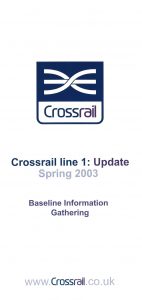
Figure 3 – Information for property owners leaflet
2.6 Establishing a 24/7 helpdesk and a stakeholder database
The project aimed to be as accessible as possible to those with questions and concerns and in 2002 a 24/7 helpdesk was set up in order to be the first point of contact for anyone enquiring about the project.
As email was not widely used among older and hard to reach groups and it was recognised that many stakeholders would not be able to contact the project during the working day, a 24/7 helpline telephone number was set up. The number was set up on a local call rate to ensure those outside London did not have to pay more to contact the project. During office hours the helpline was staffed by members of the Crossrail helpdesk with support as required from the consultation team and an out-of-hours facility was set up with a communications consultancy who provided a similar service to the Channel Tunnel Rail Link project. Stakeholders could also contact the helpdesk via a freepost address or email. Contact details for the helpdesk were added to every communication that went out from the project.
Initially one member of staff was recruited to manage the 24/7 helpdesk and stakeholder database but this expanded to a total of four during the pre-Bill phase. The helpdesk team did not work from scripts and every response was specifically tailored to the individual needs of the stakeholder.
A stakeholder database was required to keep a record of people who had contacted the project, log the information that they had been provided with and record their consultation responses and other comments. This would enable the project to collate stakeholder views for internal reporting and action but more importantly to ensure that the history of what had been communicated to an individual was available when answering subsequent enquiries. The project initially attempted to acquire bespoke systems which had been developed by predecessor projects but no deal could be struck. After several months a decision was taken to develop a customised version of an application called ACT! which worked with the Lotus Notes software which CLRL was using. During the progress of the project customer relationship management software was developing apace and ACT! was replaced by a more feature-rich Sage Saleslogix based database in 2009 which was then updated and adapted throughout the whole life span of the project. The stakeholder categories used in the database are shown in Table 1.
Table 1: Stakeholder categories (at start of public consultation)
Assembly member Government Professional Body Business Heritage Group Rail Business Business Group Inclusivity Group Religious Organisation Community Group Individual Statutory Agency Diplomatic Local Authority TfL Education Media Trade Union Emergency Services Member of Parliament Transport User Group Environment Group Peer Utility This list has been augmented during the development of the project and now includes categories which have been found appropriate to add during the delivery phase, such as ‘Crossrail Contractor’, ‘Crossrail Staff’, ‘Military’.
2.7 Production of material
Printed material was used to explain the project proposals and elicit comment. Table 2 lists and describes the items, the purpose of each and when they were produced, and provides links to them within the Learning Legacy.
Table 2: Communications Materials
Name Description Purpose When produced ‘Vision’ leaflet Postcard sized fold out introducing scheme and upcoming consultation To raise awareness of scheme and consultation among passengers and communities September 2003 Newspaper advertisements Up to half page advertisements in local press and Evening Standard announcing the consultation / giving dates of information centres To raise awareness of scheme and consultation among communities Ahead of public awareness campaign and each consultation round Information Plans Nominally A3 Ordnance Survey based maps showing route, outline of surface and below ground proposed structures, proposed limits of land to be acquired or used, and likely worksites. Also available as watermarked soft copy for emailing. To enable stakeholders to visualise the location and extent of project proposals Created ahead of Round 1 consultation (prior to draft limits being set), updated with limits prior to Round 2, updated with worksites after Round 2 and revised with each change in the project proposals Invitation leaflets 1/3 A4 folded leaflet with dates of Information Centres, also available as soft copy for emailing Hand delivered to properties and handed out near information centre locations to invite people to visit At start of each consultation and information round Information centre panels A1 foamex panels displayed on walls at Information Centres. Also available as A4 printouts and soft copies for emailing Introducing the consultation and describing proposals and key aspects of the project to inform consultees For each consultation and information round Information Pack A4 folder containing a suite of A4 or A4 folded sheets with information on issues of known concern To explain the project’s position on issues such as controlling noise, ground settlement and land acquisition For Round 1 consultation in October 2003, updated for Round 2. Quick Guide Initially A5, then ‘Z-card’ format fold out sheet with basic project information. To enable people to quickly understand the basics of the project First produced for Round 1 Consultation then updated frequently Comment Card Postage paid postcard with space for comment To make it easy for people to respond Innovation for Round 2 Report and Response A4 booklet summarising the results of each consultation round and including Crossrail’s response to issues raised To ensure consultees were aware that their views were heard and considered After each round of consultation Round 2 Consultation document A4 booklet explaining the scheme and the aim of the consultation. Introducing the consultation and describing proposals and general aspects of the project to inform consultees For Round 2 Consultation in August 2004. Information Papers (replaced Information Pack) A4 documents agreed with DfT setting out project position on a wide range of issues raised in consultation To explain the project’s position on issues which might otherwise result in petitions to the Bill For Information Round in January 2005. Crossrail retained a graphic design company to develop a style and format for project publications and the Crossrail website. The text of the various materials was initially drafted by the Communications and the Consultation sections of the Public Affairs department, with particular emphasis on writing in plain English. The information was reviewed by relevant members of the Crossrail team with responsibility for design, planning and consents. Final sign off of the Information Panels was by the Head of Public Affairs and Head of Engineering, and of the other items, by the Head of Public Affairs.
A facility was set up to enable information to be translated on request into other languages used in London, and in easy-read, Braille and audio recording, to align with practice in other London Mayoral organisations.

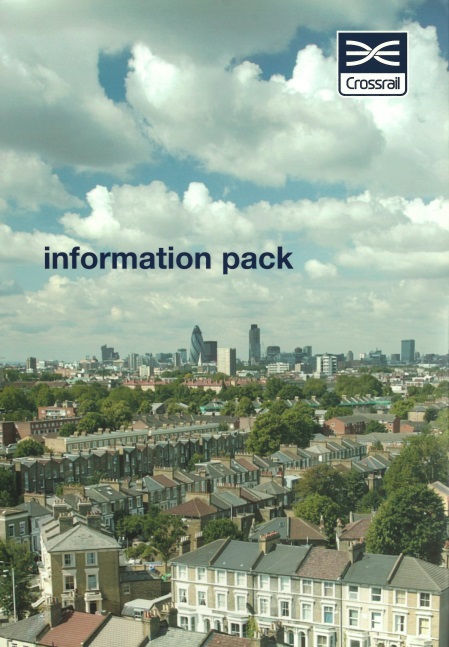
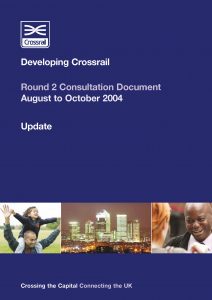
Figure 4 – Information Panel Figure 5 – Information Pack Figure 6 – Round 2 Document 2.8 Information Centres, resourcing and briefing project staff
The two consultation rounds and information round featured a programme of local exhibitions called Information Centres where the Information Panels were displayed and available to take away along with the other materials listed in Table 2. Where possible accessible local venues which would be well-known in the community were used, and where these could not be found a mobile trailer unit with ramped access was used. Locations were chosen to ensure all areas affected had an Information Centre close by and each location was visited for at least two days. The Information Centres were open from midday until 8pm to ensure people were able to visit after work and as many as practical were held on Saturdays, focused on those in town centre locations. For Round 2 in addition to the Information Centres, Project Information Exchanges were opened at Farringdon and Spitalfields for the whole duration of the consultation round. The locations and numbers of opening days are set out in the Aggregated Consultation Report.
While support was obtained from an events company to book venues and locations and set up the Information Centres, the project decided to ensure that knowledgeable project representatives who were involved in the design and development were present. This had the dual advantage of ensuring full technical answers could be given to consultee’s questions, minimising the chance of misunderstanding and building trust, and of giving the designers first hand knowledge of the concerns that they would be asked to address where possible. In order to support those staff in a communications task that was not their main area of expertise, briefing events were arranged ahead of the Information Centre programmes. Specific communications training was also arranged to advise them of ways to handle difficult enquiries. These preparations ensured all staff understood aspects of the project they may not have been closely involved in, and the importance of speaking in conditional terms and not making commitments about how the project would be delivered.
Figure 7 – Staff briefing event
Figure 8 – Information Centre on concourse at Paddington Station
As well as the Information Centres Crossrail wrote to the statutory bodies and representative groups which had been identified, offering a meeting to discuss the proposals and any concerns. The organisations contacted are listed in the Aggregated Consultation report.
2.9 Analysis of responses and review by the project
Crossrail did not seek to constrain consultees comments by asking specific questions in the consultation. This avoided the risk of influencing comments, and of being perceived to be doing so. However open-ended comments are more difficult and time-consuming to review and understand, so time was built into the programme for the consultation team to do this before reporting them within the project team. For each of the two consultation rounds the responses were reviewed by categorising them in three ways. Firstly whether they agreed, disagreed or were neutral about the project as a whole. Secondly whether a view was expressed, and was positive or negative about a list of aspects such as environmental impacts (subdivided into types of impact), transport capacity, services. Thirdly, detailed comments on the sections of the route. The full reports ran to several hundred pages so these were reported to the project leadership through presentations and discussions and disseminated to the project team through a series of meetings and workshops.
2.10 Market research
Alongside the consultation market research was commissioned to research the views of those who did not attend information centres or otherwise respond to the consultation and also to check the reach of the advertising in order that future consultation and communication could be better targeted. The research involved telephone polling in postcode areas within 2km of proposed Crossrail stations and was undertaken three times, after each of the two consultation rounds and the pre-Bill information round. It was therefore possible to track change in views about the project over time.
Figure 9 – Example of Market Research results
2.11 Feedback to consultees
In 2003 feedback was not a mandated part of consultation. However Crossrail considered that a key part of consultation was to provide a clear response to the issues raised by stakeholders. Where the project was in frequent contact this could be done in meetings and correspondence, but for the issues raised in public consultation the project published the key issues and the project’s response in the documentation for the following round (as shown in Figure 10, an extract from the Results and Response to Round 2 consultation).
Figure 10 – Page 16 of Results and Response to Round 2
2.12 Reporting
Crossrail produced a full report for each consultation round, including all comments, which was submitted to Transport for London and the Department for Transport. A summary report was also produced which was publicly available and used as background for the next phase of communication and consultation. At the end of the pre-Bill processes an Aggregated Consultation Report was produced bringing all the reports together and providing more information about the processes followed. This was very useful during the Bill committee hearings to demonstrate the effort Crossrail had taken to seek comment and revise the scheme where practical.
3. Measures of success
Measuring the success of a consultation programme is very difficult as it there is no way to know what would have happened had it been done differently. Beyond the market research results and the number of representations supported by the Referee, the only other metric available to Crossrail to assess delivery against the consultation aims is the number of petitions to the Bill, which was 577 overall. This is significantly fewer than were received to the Channel Tunnel Rail Link Bill, but the character of the schemes and the areas affected is not directly comparable. Crossrail also avoided any Judicial Review challenge which suggests the processes were considered robust.
4. Lessons learned
Some of the key lessons learned from the consultation process were:
- The Crossrail project had a firm basis in higher level policy that had also been subject to wide consultation, in that it featured in the Mayor’s Transport Strategy. This was helpful to address responses that called for the project not to proceed.
- Communities in London can be very location-focused. A venue was chosen for an information centre which was close to Whitechapel station and also around half a mile from another proposed work site at Hanbury Street. Feedback from the Hanbury Street area was that residents did not know the address and considered it outside their area so not appropriate for an event for them. This was addressed by using an additional location for Round 2.
- Crossrail policy was to direct all communication with owners of land to be acquired to be through the Property team. In one case the owners appeared to fully understand the proposals and did not petition against the acquisition, however they mounted a public campaign against acquisition after Royal Assent. The consultation team had not been aware that there might be an issue with taking possession and the project decided to revise the proposals at a late stage to address the concerns. Closer communication between the consultation and property teams may have avoided this.
- Contact with those with an interest in impacted properties was an issue. In recent years there has been an increase in the private rented sector and in non-professional landlords. This can mean that the landlord can be hard to trace, and tenants not motivated to pass on correspondence. In one case a landlord was unhappy that Crossrail contacted tenants at all.
- As expected, the value of keeping records of communication in a proper database was demonstrated on several occasions. This avoided creating frustration on the part of stakeholders when it was unavoidable that they be contacted by more than one representative of the project.
5. Recommendations for future projects
- The original expectation was that the project would proceed to an application after a single consultation round. Having two further opportunities for engagement assisted in improving the scheme. Projects should plan for an iterative consultation process.
- An independent review or audit of the consultation strategy before commencement could provide further evidence to counter any claims by consultees that an appropriate process has not been followed.
- Focus on plain English is very important. It is challenging to describe engineering and legal issues in plain terms and sometimes legal wording must be adhered to but by having clear and understandable wording, and in particular stating the consultation agenda (i.e. which aspects are and aren’t up for discussion), avoids misunderstandings. All projects should put a lot of effort into ensuring information is accessible, in every sense of the word.
- Projects should use all means available to build local knowledge as quickly as possible. This will minimise accusations of not understanding the local area and assist in identifying relevant stakeholders and suitable consultation venues.
- During land referencing and acquisition processes Consultation and Property teams should work very closely together and responses from land owners should be regularly reviewed by an integrated group, to test assumptions.
- Projects should understand and plan for the challenges relating to land acquisition communication created by shorthold tenancies and non-professional landlords alongside preparing appropriate non-statutory mitigation and compensation policies.
- Implementing the stakeholder database took 9 months in total, but about half of that time was taken up in researching off the shelf options and the systems previous projects had used. Much more powerful and accessible Customer Relationship Management Systems are now available and future projects should decide early to use one of these and integrate it into project document management and communications systems and procedures, including managing consultation responses. Procedures must ensure compliance with the General Data Protection Regulation and ensure appropriate training is provided across the project organisation. During the construction phase it should be extended to be used by all in the client and contractors who interact with the public and Helpdesk (though the client team should retain approval of the deletion of records).
- The huge increase in online access and the advent of social media since Crossrail consultation provide a great opportunity to improve engagement. However despite government policy to deliver services ‘digital by default’ future projects will still need to ensure offline media are used, to avoid excluding hard-to-reach groups.
-
Authors
Simon Bennett BEng(Hons) FCILT MCIPR AMICE - Crossrail Ltd
Simon is Head of Learning Legacy at Crossrail. A Civil Engineer, Transport Planner and Communications professional, he worked on the original 1990s Crossrail scheme for London Underground and in 2000 was seconded from TfL to Cross London Rail Links to work on developing the project and securing powers. He led the Consultation team which became the Petitions Negotiation team during the Bill process. During the construction phase he has been Head of Stakeholder Engagement and then Programme Community Relations Manager.
In 2015, Simon was appointed to lead the team responsible for the collation and dissemination of good practice, innovation and lessons learned from the Crossrail construction programme aimed at raising the bar in industry and showcasing UK PLC.
-
Acknowledgements
Sarah Goodburn, Crossrail
-
Peer Reviewers
Belinda Redpath, Tideway London Limited
Jack Day, Queenswood Engagement
